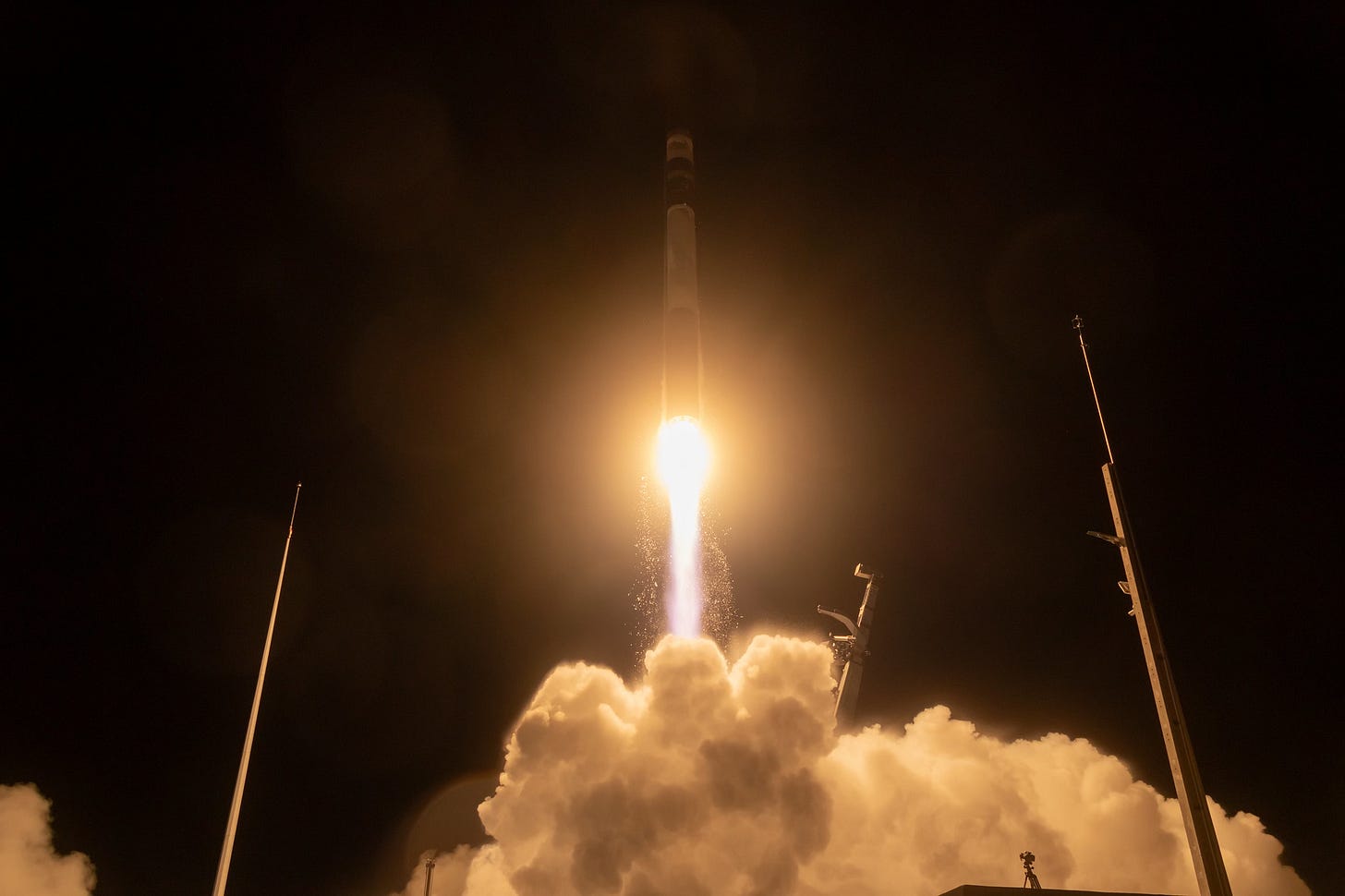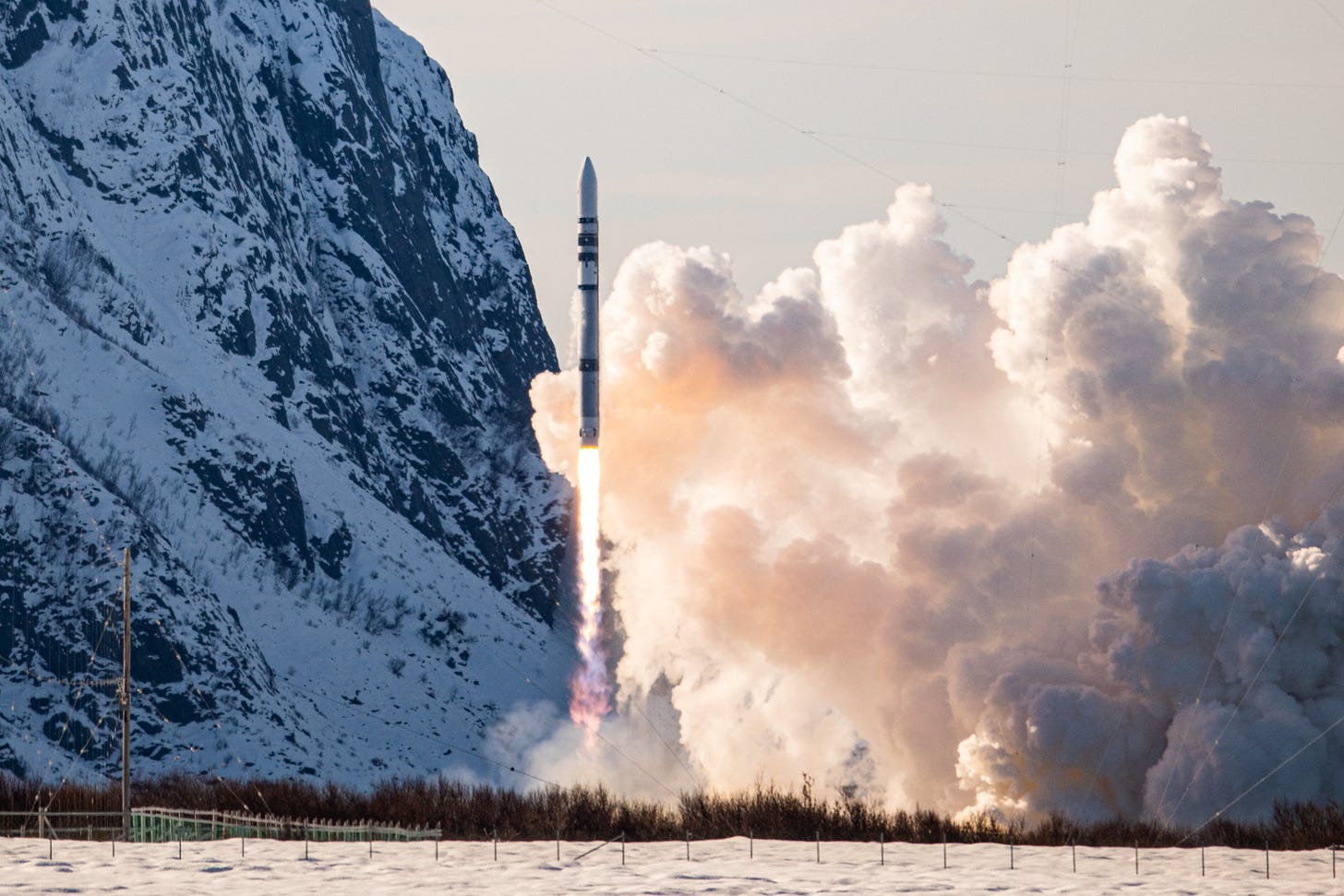Space Stocks Weekly #5
Astra Space's comeback! Rocket Lab secures NSSL $5.6B IDIQ contract, Intuitive Machines targets profitability in 2026, Spire Global appoints a new CFO, and more!
Good morning, space investors!
Before diving into this week’s updates, I want to thank you for following my weekly newsletter and welcome the seven new subscribers—AD LUNAM now has 125 subscribers!
To get my new posts directly in your inbox, you can subscribe to my newsletter here.
The format
Here’s how Space Stocks Weekly works: I start by sharing the latest news on publicly traded space companies, followed by updates on the broader space industry, including private companies.
This way, you get the full picture of what’s happening in the space industry.
Space Stocks Selloff Continues
Space Stocks VS S&P 500 — Past 30 Days Performance
Space stocks selloff continued this week. The U.S. announced its stiff tariffs on nations worldwide on Wednesday and China retaliated with a 34% tariff on all U.S. goods on Friday. Fears of a global recession are growing, interest rates remain high… and the tariff war is adding more pressure. In this kind of environment, investors tend to rotate their investment into defensive sectors like consumer staples and utilities. Many investors also move their capital into safer assets like bonds.
Most space stocks are small-cap companies. They also tend to be more volatile, less stable than larger companies and are seen as high-risk investments. So with such uncertain market conditions, these are usually the first stocks that low-risk investors sell to protect their portfolio.
A mix of inflation and high interest rates would be a rough cocktail for space stocks, because it makes borrowing more expensive. Space companies also needs to have also a stable and affordable supply chain to operate successfully. When that chain is disrupted, it impacts everything: from manufacturing to launching. That’s why, even with good news for some companies, most of them saw losses this week.
The Procure Space ETF (UFO 0.00%↑) fell more than 12%, underperforming the Russell 2000 (the index that tracks the performance of 2000 small-cap U.S. companies).
Space Stocks VS S&P 500 Since January 1, 2025
Space Stocks Updated Earnings Calendar
Here’s an updated calendar with the latest official dates for Q1 earnings reports:
LMT 0.00%↑ April 22 (Before Market Open)
IRDM 0.00%↑ April 22 (Before Market Open)
BA 0.00%↑ April 23 (Before Market Open)
RKLB 0.00%↑ May 8 (After Market Close)
Astra Space’s Comeback
Astra Space is an American aerospace company specializing in small-lift launch vehicles. You might’ve heard of this company, because they used to be public not a long ago. But after multiple launch failures and losing shareholders’ confidence, the company went private again in mid-2024. Following the transaction, Astra was valued at approximately $11.25 million.
Following its privatization, Astra raised $80 million in funding. The capital was used to complete the buyout, cover legal and transaction expenses, eliminate debt, and refinance the company. In parallel, Astra secured a major contract with the U.S. Department of Defense and established a profitable satellite engine business. Profits are now being reinvested into launch operations.
Per an article from Ashley Vance, Astra is set to resume rocket launches without the need for additional capital.
“We can continue to do this until we put a rocket back on the pad, even if we don't raise any more capital. And that's a remarkable position to be in given where we were a year ago.”
— CEO Chris Kemp
MDA Space to Acquire SatixFy
$MDA.TO has announced plans to acquire all outstanding shares of SatixFy (SATX 0.00%↑) in an all-cash transaction for US$2.10 per share (that’s a 75% premium!). This strategic move aims to integrate SatixFy technologies into MDA's end-to-end satellite offerings. SATX 0.00%↑ is a company that develops satellite communication technologies that enables satellite broadband and direct-to-device satellite connectivity.
Rocket Lab Awarded $5.6 billion IDIQ Contract for NSSL Phase 3 Lane 1
RKLB 0.00%↑ has been selected by the U.S. Space Force to bid for missions under the National Security Space Launch (NSSL) Phase 3 Lane 1 program, a contract valued at up to $5.6 billion over five years. The company plans to use their medium-lift reusable Neutron rocket to launch these national security missions. Neutron's first launch is scheduled for the second half of this year from Launch Complex 3 in Wallops Island, Virginia. Upon a successful inaugural flight, Rocket Lab will be eligible for individual task orders within the NSSL program.
Last week, Rocket Lab successfully launched eight satellites for OroraTech, a German company specializing in global wildfire detection. The mission, named "Finding Hot Wildfires Near You," lifted off from Launch Complex 1 in Mahia, New Zealand, deploying the satellites into a 550 km low Earth orbit. The launch occurred just four months after contract signing: a new milestone for Rocket Lab!
This mission marks Rocket Lab's fifth launch of 2025 and the 63rd Electron launch overall, bringing the total number of satellites deployed by the company to 224.
Rocket Lab will report their Q1 2025 earnings on May 8.
Spire Global Announces New Chief Financial Officer (CFO)
SPIR 0.00%↑ has named Alison Engel as its new Chief Financial Officer, effective April 1st, 2025. Engel brings has nearly 20 years of CFO experience and holds a master’s and bachelor’s degree in accounting from the University of Texas at Austin. She succeeds interim CFO Thomas Krywe, who will remain as an advisor through the month of April.
Intuitive Machines Expects Profitability in 2026
LUNR 0.00%↑ reported $54.7 million in Q4 revenue, up 79% year-over-year, and $228 million for 2024 (nearly three times the total revenue of 2023!) The company ended 2024 with $207.6 million in cash. This amount increased to $385 million in March 2025 after completing its warrant redemption. With this stronger balance sheet, Intuitive Machines says it’s now focused on high-return opportunities through innovation or acquisitions. The company projects $250–300 million in 2025 revenue and aims to reach positive adj. EBITDA by year-end, with full-year profitability expected in 2026.
The company’s contracted backlog reached $328.3 million at year-end, a 22% increase year-over-year, with plans to recognize as revenue up to 65% of it in 2025.
Photo of the Week
By subscribing to this newsletter, you are supporting the creation of insightful, high-quality content focused on the space industry.
As a paid subscriber, you will gain access to additional exclusive benefits:
Exclusive deep dives into space stocks and company developments
Full insights into quarterly space stock reports
Access to a subscriber-only chat for in-depth discussions and transparent updates on my portfolio moves
Upgrade today to get the most out of the space industry!
The First Crewed Mission to Orbit Earth Over Poles
On March 31, 2025, SpaceX launched the Fram2 mission from NASA's Kennedy Space Center in Florida. This flight marked the first time humans orbited Earth over both the North and South Poles. The mission was privately funded by Chun Wang, a Maltese cryptocurrency entrepreneur, who also served as the mission commander. The crew included Norwegian-British cinematographer Jannicke Mikkelsen, German robotics researcher Rabea Rogge, and Australian polar explorer Eric Philips.
The mission name, Fram2, honors the original Norwegian exploration vessel Fram, which played a key role in Arctic and Antarctic expeditions from 1893 to 1912. As a tribute, the crew brought a piece of the ship’s teak deck into space to symbolize the spirit of human exploration beyond Earth.
The First Orbital Launch from Continental Europe
On March 30, 2025, German startup Isar Aerospace launched its Spectrum rocket from Andøya Spaceport in Norway, marking the first attempt to reach orbit from continental Europe. Just 30 seconds after takeoff, the rocket crashed into the Norwegian Sea following an issue during the pitch-over maneuver.
Isar Aerospace plans to review the flight data in detail to iterate the rocket’s design, in preparation for their next launch.












